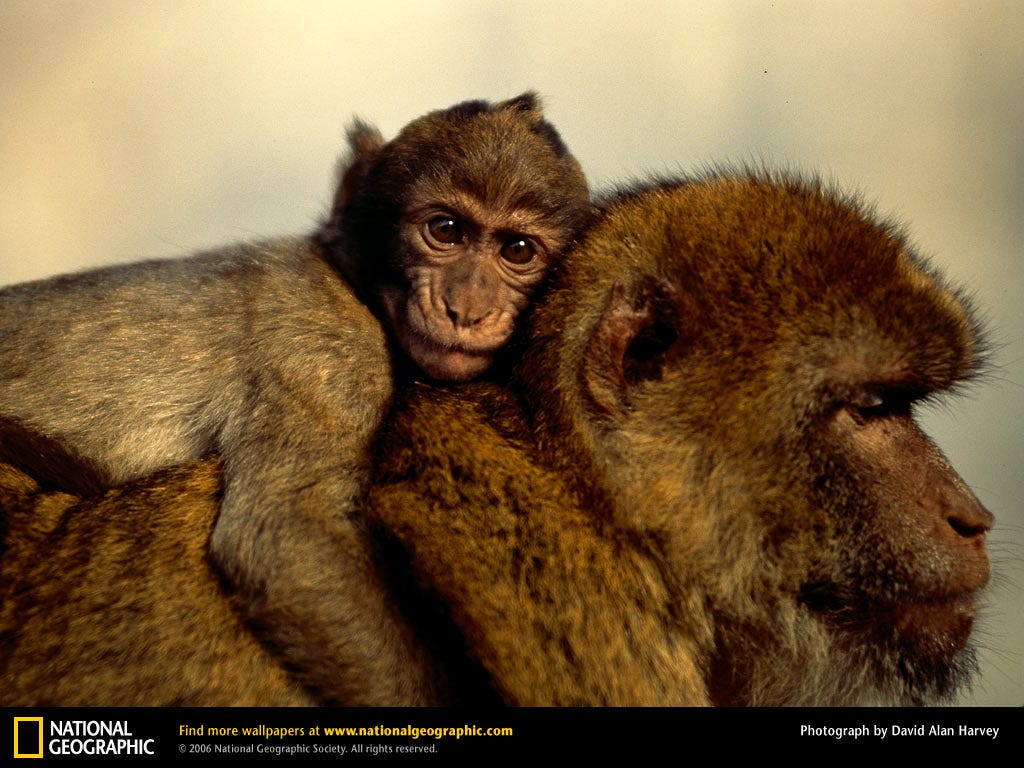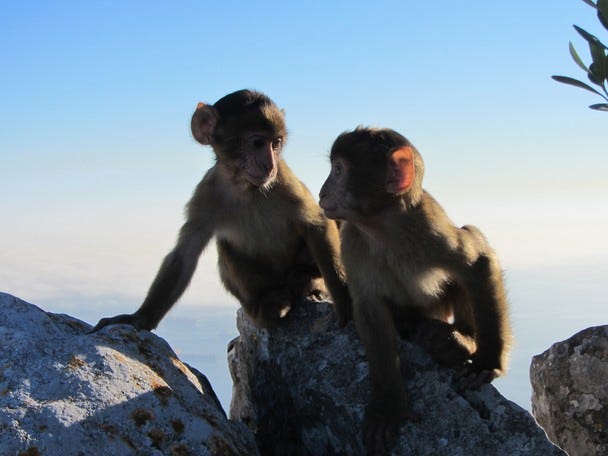Relocation of the Last Colony of Endangered Barbary Apes on Display in a US Zoo
By Jordan Schaul | National Geographic | October 5, 2013
The accredited Primate Rescue Center, a Kentucky wildlife sanctuary specializing in Old World primates, will soon care for a small troop of endangered naturally tailless Barbary macaques (Macaca sylvanus) from the Las Vegas Zoo.
The four monkeys were once claimed by the troubled roadside Las Vegas Zoo (AKA Southern Nevada Zoological-Botanical Park) to be the last and only members of the species to be displayed at a North American Zoological facility. Toronto Zoo currently holds Barbary macaques, albeit off-exhibit.
The four macaques and a chimpanzee named Terry are being relocated after the recent and sudden closing of the Zoo.
Barbary macaques are also known as Barbary apes or rock apes because they are tailless, resembling apes.
These primates have a unique distribution for not only macaques but for Old World primates in general. The ‘apes’ are found in the Rif, and High Atlas mountains of Morocco, Chréa National Park and the Kabylie mountains of Algeria, and British Gibraltar.
The established population in Gibraltar is comprised of introduced individuals, which exist in a semi-wild state.
Among the 22 extant (living) species of macaques recognized, the Barbary macaque is the only species to be found outside of Asia and represents the only extant species of primate in Africa, north of the Sahara desert. The historic range of the Barbary Ape included much of North Africa and parts of Europe.
Presumed to be of Moroccan or Algerian descent, the five troops of approximately 300 Barbary macaques in Gibraltar are considered to be, perhaps, the healthiest population of free-ranging Barbary macaques in the world and the most popular tourist attraction in the region. Today the troops, which were introduced in the 700’s, are managed by the Gibraltar Ornithological and Natural History Society.
The Queen’s Gate troop is particularly popular because of their history of close contact with people. However, feeding the troop is now prohibited and punishable by law because it has been deemed detrimental to the social dynamics and the integrity of the monkey social units. In fact, in some cases, the feeding of the monkeys has been implicated in instigating human-monkey conflict in Gibraltar and is responsible for marauding Barbary apes in and near human dwellings.
The nearly two dozen macaque species, which include the more commonly known rhesus macaque or rhesus monkey and Japanese macaque are distributed across the Asian continent from the Japanese Archipelago to Afghanistan and represent the most widespread genus of primates next to humans.
Due to the high percentage of herpes B virus carriers in this Old World monkey genus and the discovery of simian foamy virus in urban performing macaques, these once commonly displayed and studied primates have been phased out of zoological parks. In terms of their study, they have unfortunately been commonly used as animal models in invasive comparative medicine research, despite the objection of animal welfare and rights advocates and activists around the world.
The Las Vegas Zoo’s Barbary macaques were all born at the Zoo and donations to help support their future care can be sent to the Primate Rescue Center. Some other animals have been relocated to the Phoenix Zoo.
According to the Primate Rescue Center’s website, the facility is home to more than 50 primates, including “11 chimpanzees and 10 different species of monkeys.” The animals in residence “arrived [at the PRC] from research laboratories, where they had been used for everything from invasive medical procedures to human-vaccine testing; others had been abandoned by their owners, confiscated by authorities from those not licensed to keep them, or rescued from squalid, inhumane conditions. Some arrived [at the PRC] well-adjusted and in reasonably good health; others arrived malnourished, or in need of corrective surgery, or so psychologically damaged they shunned all contact with humans and other monkeys.”
Incidentally, the sanctuary facility I work for in Southern California, the Wildlife Waystation, has a rescued crab-eating macaque (AKA cynomolgus monkey) or long-tailed macaque, several New World monkeys, and the largest chimpanzee colony in the region in its care. Similarly, the animals were confiscated by their owners or relocated from research laboratories.
If you are interested in macaques, please read my last post on rhesus monkeys for Nat Geo News
ABOUT NATIONAL GEOGRAPHIC SOCIETY
The National Geographic Society is a global nonprofit organization that uses the power of science, exploration, education and storytelling to illuminate and protect the wonder of our world. Since 1888, National Geographic has pushed the boundaries of exploration, investing in bold people and transformative ideas, providing more than 14,000 grants for work across all seven continents, reaching 3 million students each year through education offerings, and engaging audiences around the globe through signature experiences, stories and content. To learn more, visit www.nationalgeographic.org or follow us on Instagram, Twitter and Facebook.
MEET THE AUTHOR
Jordan Carlton SchaulWith training in wildlife ecology, conservation medicine and comparative psychology, Dr. Schaul's contributions to Nat Geo Voices have covered a range of environmental and social topics. He draws particular attention to the plight of imperiled species highlighting issues at the juncture or nexus of sorta situ wildlife conservation and applied animal welfare. Sorta situ conservation practices are comprised of scientific management and stewardship of animal populations ex situ (in captivity / 'in human care') and in situ (free-ranging / 'in nature'). He also has a background in behavior management and training of companion animals and captive wildlife, as well as conservation marketing and digital publicity. Jordan has shared interviews with colleagues and public figures, as well as editorial news content. In addition, he has posted narratives describing his own work, which include the following examples: • Restoration of wood bison to the Interior of Alaska (As Animal Curator at Alaska Wildlife Conservation Center and courtesy professor at the University of Alaska) • Rehabilitation of orphaned sloth bears exploited for tourists in South Asia (As executive consultant 'in-residence' at the Agra Bear Rescue Center managed by Wildlife SOS) • Censusing small wild cat (e.g. ocelot and margay) populations in the montane cloud forests of Costa Rica for popular publications with 'The Cat Whisperer' Mieshelle Nagelschneider • Evaluating the impact of ecotourism on marine mammal population stability and welfare off the coast of Mexico's Sea of Cortez (With Boston University's marine science program) Jordan was a director on boards of non-profit wildlife conservation organizations serving nations in Africa, North and South America and Southeast Asia. He is also a consultant to a human-wildlife conflict mitigation organization in the Pacific Northwest. Following animal curatorships in Alaska and California, he served as a charter board member of a zoo advocacy and outreach organization and later as its executive director. Jordan was a member of the Communication and Education Commission of the International Union for the Conservation of Nature (CEC-IUCN) and the Bear Specialist Group of the IUCN Species Survival Commission (BSG-SSC-IUCN). He has served on the advisory council of the National Wildlife Humane Society and in service to the Bear Taxon Advisory Group of the Association of Zoos and Aquariums (AZA Bear TAG). In addition,he was an ex officio member of the council of the International Association for Bear Research and Management.




